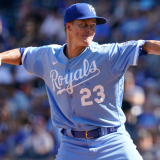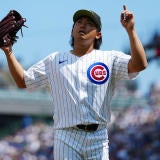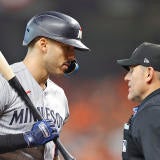
After a few days off, Major League Baseball's postseason will resume on Sunday, when the Houston Astros and Texas Rangers kick off the American League Championship Series. The Philadelphia Phillies and Arizona Diamondbacks will then begin the National League's equivalent on Monday. Before those series can get underway, we here at CBS Sports wanted to highlight two X-factors that could determine each pennant winner.
You might think that "X-factor" is a nebulous term that gets thrown around far too often this time of the year as an excuse for the author to explore subplots they might otherwise lack the space or justification to get into. You would be 100% correct about that. Creative liberty, what a tremendous thing.
Now, onto the good stuff.
ALCS: Rangers vs. Astros
X-factor No. 1: Breaking balls
Generally speaking, there are three kinds of "X-factor" scenarios: 1) when a strength meets a weakness; 2) when a weakness meets a weakness; and 3) when a strength meets a strength. The last one applies here.
During the regular season, the Astros threw the fifth-highest rate of breaking balls in the majors. (The "breaking ball"classification includes sliders, curveballs, and sweepers, for those wondering.) The Rangers' lineup, meanwhile, posted the highest OPS in the AL against breaking balls. Which strength will end up winning out here? That's where the intrigue lies.
Without overstating things, this particular X-factor could become important late in games. The Houston pitchers most likely to spam their breakers were all relievers: closer Ryan Pressly and right-handers Phil Maton and Bryan Abreu. Each threw at least 58% breaking balls during the regular season. Starters Justin Verlander and Cristian Javier were both over 35% as well.
On the Rangers side, their top performers against breakers are exactly who you would expect: Corey Seager, Adolis García, and Marcus Semien. Each of those three had an OPS over .800 against that pitch family during the regular season. Some of their regulars really struggled against breakers, however, giving Houston's pitching staff some potential pockets to exploit this series.
To wit, take a look at the breaking ball OPS by Texas' most recently used starting nine:
| Batter | Breaking ball OPS | PA |
|---|---|---|
Marcus Semien | .803 | 237 |
Corey Seager | .952 | 162 |
.732 | 113 | |
Adolis García | .856 | 205 |
.717 | 16 | |
.506 | 115 | |
Nathaniel Lowe | .646 | 210 |
.675 | 198 | |
.588 | 148 |
We've seen the Astros take a more aggressive approach with their breaker usage in the past. Lance McCullers Jr. famously threw 24 consecutive to close out the New York Yankees in the 2017 ALCS:
The Astros may not opt for as extreme of a strategy this series. But, if they do, facing the bottom of Texas' lineup seems like a good time to break it out.
X-factor No. 2: Who pitches to Alvarez late?
Realistically, the Astros' lineup is too good to obsess over plans for a single batter. Yordan Alvarez sure made a case for demanding the spotlight during Houston's ALDS victory against the Minnesota Twins. In four games, he went 7 for 16 with two doubles and four home runs. He drove in six runs.
It's on manager Bruce Bochy to find some kind of solution to Alvarez in the late innings. To that, we say: good luck. Take a look at Alvarez's OPS the last three seasons against each pitch type, split by pitcher handedness:
| Pitch type | LHP | RHP |
|---|---|---|
Four-seamers | 1.078 | 1.008 |
Two-seamers | .647 | 1.166 |
Cutters | 1.061 | .864 |
Sliders | .977 | .971 |
Curves | .824 | .690 |
Changeups | .938 | 1.021 |
For those who weren't keeping count, Alvarez has an OPS below .800 on exactly two kinds of pitch types: left-handed two-seamers and right-handed curveballs. Ignoring for a second that Alvarez's performance against those particular pitches may vary based on velocity, movement, and release point profiles -- let's face it, nobody reading this wants us to get that nerdy -- here are relievers from the Rangers' ALDS roster who fit those parameters (by which we mean they threw at least 15% of that pitch type in-season):
- Lefty sinkers: Martín Pérez, Aroldis Chapman.
- Righty curves: Josh Sborz, Chris Stratton.
Chapman and Sborz were certain to see high-leverage work in this series anyway. In that sense, it works out nicely for the Rangers. We will note that last postseason provided a good reminder that even the "smart" play against Alvarez can end in failure:
In other words, tread carefully.
NLCS: Phillies vs. Diamondbacks
X-factor No. 1: Heaters
We mentioned above that X-factors often fall into one of three categories. Here, we're focusing on a perceived strength versus a perceived weakness. During the regular season, the Phillies threw the fifth most fastballs and sinkers; the Diamondbacks, accordingly, ranked 16th in production versus fastballs and sinkers -- that's the third-worst mark among playoff teams.
Bear in mind that we're painting broadly here. Some hitters are better at getting on top of rising four-seamers, just as some are more skilled at lifting sinkers. What theoretically makes the Phillies a tough matchup in this respect is that they're one of the teams that came closest to a 1:1 share of four-seamers and two-seamers during the regular seasons (28.3% versus 22.5%).
Here's a look at the D-backs who performed worse against those distinct fastballs:
Versus four-seamers: Lourdes Gurriel Jr.; Geraldo Perdomo; Evan Longoria.
Versus sinkers: Alek Thomas; Gabriel Moreno; Geraldo Perdomo.
We'll note that some of the D-backs' worst offenders in this respect are unlikely to factor into the NLCS. Josh Rojas was traded at the deadline; Nick Ahmed was waived near the end of the season; Jake McCarthy is injured; and spare infielders Jace Peterson, Jordan Lawlar, and Emmanuel Rivera received a total of one at-bat during the NLDS and zero during the Wild Card Series.
As such, this may not end up being as big of a factor as it appears at first blush. The Diamondbacks still may face a clear disadvantage whenever the Phillies pump heaters in against Alek Thomas and Geraldo Perdomo.
X-factor No. 2: The running game
It's no secret: these teams like to run. The Diamondbacks finished second in the majors during the regular season with 166 stolen bases. The Phillies ranked seventh with 141. Both teams kept up their thieving ways in the playoffs. In the DS round, the Phillies went seven for eight in four games versus the Braves, and the Diamondbacks went five for six in three games against the Dodgers.
While pitchers, not catchers, are usually the ones responsible for shutting down the running game, we feel obligated to note that both backstops were better at throwing out prospective thieves than Statcast's model projected during the regular season.
Indeed, Arizona's Gabriel Moreno actually led the majors with nine caught stealings above above. Philadelphia's J.T. Realmuto, conversely, threw out two more runners than expected. Here's a look at some of their advanced metrics:
| Backstop | Pop time | Arm strength | CS% |
|---|---|---|---|
Moreno | 1.90 seconds | 79.5 mph | 48% |
Realmuto | 1.84 seconds | 83.1 mph | 22% |
Will either be enough to keep Corbin Carroll, Trea Turner, or Bryson Stott tethered to first base? Almost certainly not. But the quality of both catchers will make those stolen-base opportunities all the more exciting to watch.






















